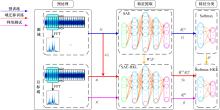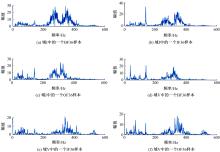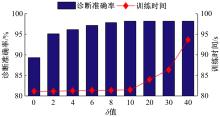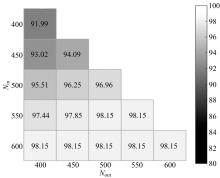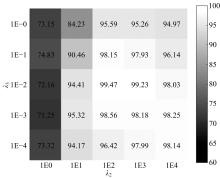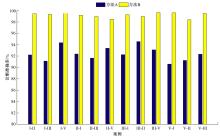Journal of Jilin University(Engineering and Technology Edition) ›› 2020, Vol. 50 ›› Issue (5): 1617-1626.doi: 10.13229/j.cnki.jdxbgxb20190493
A transfer learning model for bearing fault diagnosis
Gen-bao ZHANG1,2,3( ),Hao LI1,Yan RAN1,2(
),Hao LI1,Yan RAN1,2( ),Qiu-jin LI1
),Qiu-jin LI1
- 1.College of Mechanical Engineering, Chongqing University, Chongqing 400044, China
2.State Key Laboratory of Mechanical Transmissions, Chongqing University, Chongqing 400044, China
3.School of Intelligent Manufacturing Engineering, Chongqing University of Arts and Sciences, Chongqing 402160, China
CLC Number:
- TH17
| 1 | Yin J L, Wang W Y, Man Z H, et al. Statistical modeling of gear vibration signals and its application to detecting and diagnosing gear faults[J]. Information Sciences, 2014, 259: 295-303. |
| 2 | Li W, Zhu Z C, Jiang F, et al. Fault diagnosis of rotating machinery with a novel statistical feature extraction and evaluation method[J]. Mechanical Systems and Signal Processing, 2015, 50/51: 414-426. |
| 3 | Shen C Q, Wang D, Kong F R, et al. Fault diagnosis of rotating machinery based on the statistical parameters of wavelet packet paving and a generic support vector regressive classifier[J]. Measurement, 2013, 46(4): 1551-1564. |
| 4 | 马辉, 车迪, 牛强, 等. 基于深度神经网络的提升机轴承故障诊断研究[J]. 计算机工程与应用, 2019(16): 123-129. |
| Ma Hui, Che Di, Niu Qiang, et al. Fault diagnosis of elevator bearing based on deep neural network[J]. Computer Engineering and Applications, 2019(16): 123-129. | |
| 5 | 刘文朋, 廖英英, 杨绍普, 等. 一种基于多点峭度谱和最大相关峭度解卷积的滚动轴承故障诊断方法[J]. 振动与冲击, 2019, 38(2): 146-151, 163. |
| Liu Wen-peng, Liao Ying-ying, Yang Shao-pu, et al. Fault diagnosis of rolling bearings based onmultipoint kurtosis spectrums and the maximum correlated kurtosis deconvolution method[J]. Journal of Vibration and Shock, 2019, 38(2): 146-151, 163. | |
| 6 | 郝研, 王太勇, 万剑, 等. 基于经验模式分解和广义维数的机械故障诊断[J]. 吉林大学学报: 工学版, 2012, 42(2): 392-396. |
| Hao Yan, Wang Tai-yong, Wan Jian, et al. Mechanical fault diagnosis based on empirical mode decomposition and generalized dimension[J]. Journal of Jilin University(Engineering and Technology Edition), 2012, 42(2): 392-396. | |
| 7 | 高立新, 张建宇, 崔玲丽, 等. 基于小波分析的低速重载设备故障诊断[J]. 机械工程学报, 2005, 41(12): 222-227. |
| Gao Li-xin, Zhang Jian-yu, Cui Ling-li, et al. Research on fault diagnosis technology of low speed and heavy duty equipments based on wavelet analysis[J]. Chinese Journal of Mechanical Engineering, 2005, 41(12): 222-227. | |
| 8 | 李文军, 张洪坤, 程秀生. 基于小波和神经网络的传感器故障诊断[J]. 吉林大学学报: 工学版, 2004, 344(3): 491-495. |
| Li Wen-jun, Zhang Hong-kun, Cheng Xiu-sheng. Sensor fault diagnosis based on wavelet and neural network[J]. Journal of Jilin University(Engineering and Technology Edition), 2004, 34(3): 491-495. | |
| 9 | Jia F, Lei Y G, Lin J, et al. Deep neural networks: a promising tool for fault characteristic mining and intelligent diagnosis of rotating machinery with massive data[J]. Mechanical Systems and Signal Processing, 2016, 72/73: 303-315. |
| 10 | 牟亮, 王凯, 李彦, 等. 层叠P阶多项式主成分分析在轴承故障诊断中的应用[J]. 振动与冲击, 2019, 38(2): 25-32. |
| Mu Liang, Wang Kai, Li Yan, et al. Bearing fault diagnosis based on the stacked P-order polynomial principal component analysis[J]. Journal of Vibration and Shock, 2019, 38(2): 25-32. | |
| 11 | 程利军, 张英堂, 李志宁, 等. 基于时频分析及阶比跟踪的曲轴轴承故障诊断研究[J]. 振动与冲击, 2012, 31(19): 73-78. |
| Cheng Li-jun, Zhang Ying-tang, Li Zhi-ning, et al. Research on fault diagnose of main bearing based on time-frequency analysis and order tracking[J]. Journal of Vibration and Shock, 2012, 31(19): 73-78. | |
| 12 | 陶新民, 徐晶, 刘兴丽, 等. 基于最大小波奇异谱的轴承故障诊断方法[J]. 振动、测试与诊断, 2010, 30(1): 78-82. |
| Tao Xin-min, Xu Jing, Liu Xing-li, et al. Fault diagnosis of bearing using maximum wavelet singular spectrum[J]. Journal of Vibration, Measurement & Diagnosis, 2010, 30(1): 78-82. | |
| 13 | 庄福振, 罗平, 何清, 等. 迁移学习研究进展[J]. 软件学报, 2015, 26(1): 26-39. |
| Zhuang Fu-zhen, Luo Ping, He Qing, et al. Survey on transfer learning research[J]. Journal of Software, 2015, 26(1): 26-39. | |
| 14 | Zhang R, Tao H Y, Wu L F, et al. Transfer learning with neural networks for bearing fault diagnosis in changing working conditions[J]. IEEE Access, 2017(5): 14347-14357. |
| 15 | Han D M, Liu Q G, Fan W G. A new image classification method using CNN transfer learning and web data augmentation[J]. Expert Systems with Applications, 2018, 95: 43-56. |
| 16 | Chen D M, Yang S, Zhou F N. Incipient fault diagnosis based on DNN with transfer learning[C]∥International Conference on Control, Automation and Information Sciences, Hangzhou, China, 2018: 303-308. |
| 17 | Karsten M B, Arthur G, Malte R, et al. Integrating structured biological data by kernel maximum mean discrepancy[J]. Bioinformatics, 2006, 22(14): 49-57. |
| 18 | Lu W N, Liang B, Cheng Y, et al. Deep model based domain adaptation for fault diagnosis[J]. IEEE Transactions on Industrial Electronics, 2017, 64(3): 2296-2305. |
| 19 | Wen L, Gao L, Li X Y. A new deep transfer learning based on sparse auto-encoder for fault diagnosis[J]. IEEE Transactions on Systems, Man, and Cybernetics: Systems, 2019, 49(1): 136-144. |
| 20 | Ding Z M, Fu Y. Robust transfer metric learning for image classification[J]. IEEE Transactions on Image Processing, 2017, 26(2): 660-670. |
| 21 | Jiang L, Ge Z Q, Song Z H. Semi-supervised fault classification based on dynamic sparse stacked auto-encoders model[J]. Chemometrics and Intelligent Laboratory Systems, 2017, 168: 72-83. |
| 22 | Zheng Y L, Wang T Z, Xin B, et al. A sparse autoencoder and softmax regression based diagnosis method for the attachment on the blades of marine current turbine[J]. Sensors, 2019, 19(4): 826. |
| 23 | Qian W W, Li S M, Wang J R. A new transfer learning method and its application on rotating machine fault diagnosis under variant working conditions[J]. IEEE Access, 2018(6): 1-11. |
| 24 | 朱冰, 蒋渊德, 邓伟文, 等. 基于KL散度的驾驶员驾驶习性非监督聚类[J]. 汽车工程, 2018, 40(11): 1317-1323. |
| Zhu Bing, Jiang Yuan-de, Deng Wei-wen, et al. Unsupervised clustering of driving styles based on KL divergence[J]. Automotive Engineering, 2018, 40(11): 1317-1323. | |
| 25 | Case Western Reserve University. Bearing data center[DB/OL]. [2019-04-28]. file |
| 26 | Yang B, Lei Y G, Jia F, et al. An intelligent fault diagnosis approach based on transfer learning from laboratory bearings to locomotive bearings[J]. Mechanical Systems and Signal Processing, 2019, 122: 692-706. |
| [1] | JIANG Tao,LIN Xue-dong,LI De-gang,YANG Miao,TANG Xue-lin. Effect of control parameters on heat release rate with ANN method [J]. Journal of Jilin University(Engineering and Technology Edition), 2018, 48(6): 1747-1754. |
| [2] | WANG De-jun, WEI Wei-li, BAO Ya-xin. Actuator fault diagnosis of ESC system considering crosswind interference [J]. Journal of Jilin University(Engineering and Technology Edition), 2018, 48(5): 1548-1555. |
| [3] | SONG Da-feng, LI Guang-han, ZHANG Lin, PAN Bing, ZENG Xiao-hua, PENG Yu-jun, WANG Qing-nian. Application of fuzzy mathematics in fault diagnosis of motor of hybrid vehicle [J]. 吉林大学学报(工学版), 2016, 46(2): 354-359. |
| [4] | OUYANG Dan-tong,CHI Jin-jin,WANG Xiao-yu,ZHAO Xiang-fu ,MENG Xiang-yu. Approach of diagnosis of higher-order discrete event systems [J]. 吉林大学学报(工学版), 2015, 45(2): 562-568. |
| [5] | SONG Bao-yu,XIE Zhi-jie,ZHANG Feng,WANG Rui-ze,HAO Ming-hui,SU Dai-zhong. Fault diagnosis algorithm for helical gear rotating at low speed on angular domain synchronous average and order tracking analysis [J]. 吉林大学学报(工学版), 2015, 45(2): 454-459. |
| [6] | HOU A-lin, LIAO Qing, JIN Zhi-juan, CHEN Juan, GENG Ying. Compression algorithm of computer-generated hologram based on artificial neural network [J]. 吉林大学学报(工学版), 2013, 43(增刊1): 21-24. |
| [7] | WU Jian, ZHAO Yang, HE Rui. Fault detection and diagnosis of EMB sensor system based on SVR [J]. 吉林大学学报(工学版), 2013, 43(05): 1178-1183. |
| [8] | HAO Yan, WANG Tai-yong, WAN Jian, ZHANG Pan, LIU Lu. Mechanical fault diagnosis based on empirical mode decomposition and generalized dimension [J]. 吉林大学学报(工学版), 2012, 42(02): 392-396. |
| [9] | CHEN Yun-han, QIN Gui-he, YU He, HUANG Yue. In-vehicle network management system complied with OSEK/VDX direct NM [J]. 吉林大学学报(工学版), 2011, 41(05): 1407-1413. |
| [10] | KONG Fan-sen,WU Ya-fu,LI Cong. Assessment of fault diagnosis complexity about electrical fault diagnosis of equipment based on information entropy [J]. 吉林大学学报(工学版), 2011, 41(03): 697-701. |
| [11] | JIA Zhi-Xin, ZHANG Hong-Bin, XI An-Min. Expanding reliability data of NC machine tool based on neural network [J]. 吉林大学学报(工学版), 2011, 41(02): 403-0407. |
| [12] | GAO Yin-Han, SUN Qiang, CONG Yu-Liang, CHi Jun-Cheng, TANG Rong-Jiang. Non-steady noise quality evaluation method based on neural network [J]. 吉林大学学报(工学版), 2010, 40(增刊): 110-0114. |
| [13] | SHAO Ji-ye,WANG Ri-xin,XU Min-qiang. Application of Bayesian network in model-based fault diagnosis [J]. 吉林大学学报(工学版), 2010, 40(01): 234-0237. |
| [14] | YIN Yong-guang,DING Yun. Rapid method for enumeration of Escherichia coli in food based on computer vision [J]. 吉林大学学报(工学版), 2009, 39(增刊2): 344-0348. |
| [15] | LIU Yu-mei,SU Jian,CAO Xiao-ning,XIONG Wei,SONG Xue-zhong. Study on fault diagnosis methods for automobile suspensions based on fuzzy mathematics [J]. 吉林大学学报(工学版), 2009, 39(增刊2): 220-0224. |
|
||
